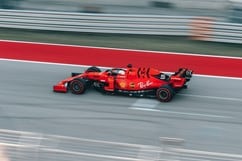Safety Devices Introduced In F1 Since 2010

In its more than 70 years of history, Formula 1 has come a long way in safety and security in racing. When Formula 1 started, the risk associated with motorsport was death and severe injury.
However, owing to several fatal accidents and incidents, Formula 1 strives to increase safety for its drivers. Since 2010, the FIA has introduced a slew of safety devices to make the sport a safe experience. Here's looking at every safety device introduced in F1 since 2010.
Accelerometer – Introduced in 2014
Since 2014, drivers in F1 have accelerometers in their earpieces to gather accurate information. With the accelerometer, they can better understand the forces acting on the car. This device shows the exact movement of the driver's head during an impact. Especially after a crash, the accelerometer is very important. FIA chose ears as it was a non-invasive and ideal spot for placing the device.

Photo Credit: unsplash.com
Driver Facing Camera – Introduced in 2016
Driver-facing cameras were installed inside the cars in 2016 to help analyse what happened inside the cockpit during a crash. With a frame rate of 400 fps, the camera picks up every tiny moment inside the cockpit. It works with the accelerometer and Accident Data Recorder to deliver data and enhance safety. Moreover, the camera is completely integrated into the cockpit to ensure that it doesn't interfere during the race.
The Halo – Introduced in 2018
Halo was one of the most thoughtful moves to enhance driver safety in Formula racing. It is a cockpit protection device that secures the driver's head to prevent injury during an impact. The device was quite controversial as experts argued that it could hinder visibility for the drivers. However, after several incidents on the tracks where the halo came in handy, the furiousness and debates around the device died down. The device protects drivers' heads from flying debris.

Photo Credit: unsplash.com
Biometric Gloves – Introduced in 2018
Another safety innovation that made it to Formula racing in 2018 is biometric gloves. This innovation can give a better idea of the driver's health status after a crash. The gloves transmit the driver's pulse and blood oxygen levels to race control. Thanks to the data from the gloves, the medical team can better cater to the drivers' injuries.
Gloves with Fire Protection – Tried in 2021
These gloves haven't been introduced yet as they are still undergoing trials. The importance of these gloves was realised after an incident involving Romain Grosjean. Grosjean survived the incident but ended up with severely burnt hands. As a part of a continuous effort to enhance driver's safety, FIA started working on these fire protection gloves.

Photo Credit: unsplash.com
FIA displays continuous efforts to increase safety in Formula racing. Now more than ever, Formula 1 seems to be focusing the most on the driver's safety!
Latest News
 Jaiveer Mehra | Jan 7, 2026Tata Harrier, Safari Petrol Launched In India: Prices Start From Rs 12.89 LakhBoth SUVs get the 1.5-litre Hyperion turbo-petrol engine from the Sierra in a higher state of tune.3 mins read
Jaiveer Mehra | Jan 7, 2026Tata Harrier, Safari Petrol Launched In India: Prices Start From Rs 12.89 LakhBoth SUVs get the 1.5-litre Hyperion turbo-petrol engine from the Sierra in a higher state of tune.3 mins read Carandbike Team | Jan 7, 2026Toyota Urban Cruiser EV India Debut On January 19Toyota’s entry EV is the sister model to the Maruti Suzuki e Vitara and shares the same underpinnings and tech.1 min read
Carandbike Team | Jan 7, 2026Toyota Urban Cruiser EV India Debut On January 19Toyota’s entry EV is the sister model to the Maruti Suzuki e Vitara and shares the same underpinnings and tech.1 min read car&bike Team | Jan 7, 2026Tata Punch Facelift Variants, Key Features RevealedThe Punch facelift will be offered in four familiar key trim levels and six variants.1 min read
car&bike Team | Jan 7, 2026Tata Punch Facelift Variants, Key Features RevealedThe Punch facelift will be offered in four familiar key trim levels and six variants.1 min read car&bike Team | Jan 7, 2026Skoda Kylaq Prices Hiked By Up To Rs 19,000Prices for the Kylaq subcompact SUV now start at Rs 7.59 lakh (ex-showroom).1 min read
car&bike Team | Jan 7, 2026Skoda Kylaq Prices Hiked By Up To Rs 19,000Prices for the Kylaq subcompact SUV now start at Rs 7.59 lakh (ex-showroom).1 min read Amaan Ahmed | Jan 7, 2026Ather 450X To Get Cruise Control; All 2025 Examples Will Receive Infinite Cruise Via OTA UpdateMore than 44,000 customers who bought the Ather 450X in 2025 will be eligible for the over-the-air update that will introduce 'Infinite Cruise'.1 min read
Amaan Ahmed | Jan 7, 2026Ather 450X To Get Cruise Control; All 2025 Examples Will Receive Infinite Cruise Via OTA UpdateMore than 44,000 customers who bought the Ather 450X in 2025 will be eligible for the over-the-air update that will introduce 'Infinite Cruise'.1 min read Jaiveer Mehra | Jan 7, 2026Afeela SUV Prototype Is Sony-Honda’s Next EVThe second model under the Sony-Honda joint venture to debut in production guise in 2028.1 min read
Jaiveer Mehra | Jan 7, 2026Afeela SUV Prototype Is Sony-Honda’s Next EVThe second model under the Sony-Honda joint venture to debut in production guise in 2028.1 min read
 Amaan Ahmed | Jan 3, 2026VLF Mobster 135 300 KM Review: Fun But FlawedA 125 cc scooter with Italian design and Chinese genes is a rare combination, and while some may be tempted to dismiss it because of its origins, the VLF Mobster shows 125s can also be exciting – but not without compromises.11 mins read
Amaan Ahmed | Jan 3, 2026VLF Mobster 135 300 KM Review: Fun But FlawedA 125 cc scooter with Italian design and Chinese genes is a rare combination, and while some may be tempted to dismiss it because of its origins, the VLF Mobster shows 125s can also be exciting – but not without compromises.11 mins read Preetam Bora | Dec 30, 2025TVS Orbiter Review: Real-World Performance and Range TestedThe TVS Orbiter is a promising electric scooter promising decent range, practicality and pricing. But is there any reason to avoid it? We spent a few days getting to know it better.9 mins read
Preetam Bora | Dec 30, 2025TVS Orbiter Review: Real-World Performance and Range TestedThe TVS Orbiter is a promising electric scooter promising decent range, practicality and pricing. But is there any reason to avoid it? We spent a few days getting to know it better.9 mins read Jafar Rizvi | Dec 24, 2025MG Windsor EV 38 kWh Long-Term Report: IntroductionThe Windsor EV has joined our garage, and before it settles into daily duty, I took it out to get a sense of what living with an electric car is like.4 mins read
Jafar Rizvi | Dec 24, 2025MG Windsor EV 38 kWh Long-Term Report: IntroductionThe Windsor EV has joined our garage, and before it settles into daily duty, I took it out to get a sense of what living with an electric car is like.4 mins read Seshan Vijayraghvan | Dec 23, 20252026 Kia Seltos Review: Formula Is Spot On, But Is The Timing Right?The 2nd-gen Kia Seltos has arrived, but it has the challenge of facing strong rivals like the Victoris and Sierra. The question is simple - Does it still have what it takes?9 mins read
Seshan Vijayraghvan | Dec 23, 20252026 Kia Seltos Review: Formula Is Spot On, But Is The Timing Right?The 2nd-gen Kia Seltos has arrived, but it has the challenge of facing strong rivals like the Victoris and Sierra. The question is simple - Does it still have what it takes?9 mins read car&bike Team | Dec 26, 2025Tata Punch EV Long-Term Second Report: Highway Performance, Pros & ConsAfter a week of living with the Tata Punch EV Long Range—including a proper Mumbai-Nashik highway test—we've learned what this little electric SUV is really made of.1 min read
car&bike Team | Dec 26, 2025Tata Punch EV Long-Term Second Report: Highway Performance, Pros & ConsAfter a week of living with the Tata Punch EV Long Range—including a proper Mumbai-Nashik highway test—we've learned what this little electric SUV is really made of.1 min read






















































































































